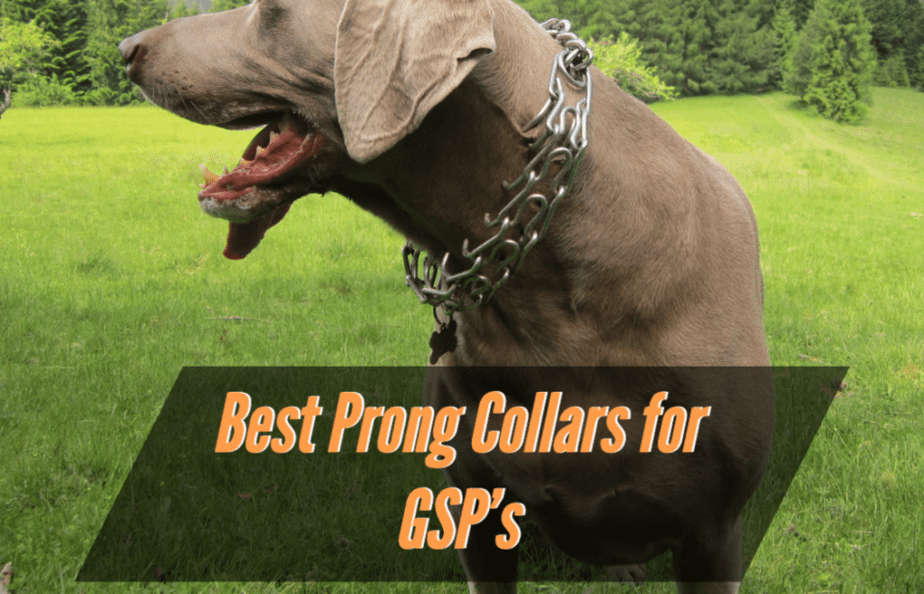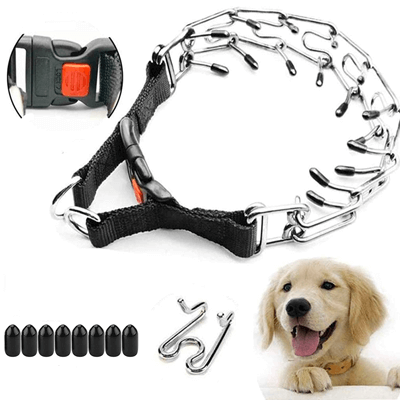If you’re new to dog ownership, the array of dog “stuff” can be overwhelming.
There are so many types of collars, leads, toys, beds…the list goes on.
But if you have a German shorthaired pointer, there are some specific things you should think about before settling on your purchase.
Choosing the right collar is a crucial decision when it comes to caring for your German shorthaired pointer.
Every dog collar has its own advantages and disadvantages, which can sometimes make it difficult to choose the best one.
In this article, you will learn about all of your options, as well as how to choose the perfect prong collar for your pup!

Why Is it Important to Choose the Right Collar?
A collar is an important part of your dog’s equipment because it should be the only thing that you need to use to control your dog.
If it’s not fitted properly, it can cause problems. Some dogs are agile enough to slip out of their collar if it’s not the right size, putting your GSP at risk.
How to Choose the Best Collar for Your German Shorthaired Pointer
If you’re a new German shorthaired pointer (GSP) owner, it’s important to consider all of your options when it comes to a collar.
Every dog collar has its own advantages and disadvantages, which can sometimes make it difficult to choose the best one.
In this article, you will learn about all of your options, as well as how to choose the perfect collar for your pup!
The Different Kinds of Collars for German Shorthaired Pointers
Collars for GSPs are available in a variety of different styles.
There is the standard flat or rolled leather collar, martingale, limited slip collars, prong collars, choker chains, and even nylon.

The Best Collar for Your Dog
There are many different styles and types of collars available on the market. Some people choose a slip collar because it is versatile and can be adjusted to fit any size dog.
Slip collars are typically used for teaching your dog how to behave in public. They’re similar to choker chain collars, but are much less harmful.
A martingale collar is another popular option because it doesn’t tighten too much, which means your pup won’t end up hurting themselves trying to escape.
One of the main downsides to this type of collar is that some dogs find it uncomfortable and don’t like wearing it.
A prong collar poses even more risk of harming your GSP, but can be necessary during the early stages of training.
Not all prong collars pose an equal risk, and there are many different options available, so choosing the best one can be challenging.
The Best Prong Collar for German Shorthaired Pointers

If your GSP has the tendency to pull you down the sidewalk, a prong collar may not be the best option.
Prong collars can easily damage the sensitive skin around the neck, and potentially damage more important parts such as the trachea, the thyroid, and the esophagus.
However, not all GSPs are prone to excessive pulling when walking, so they pose less risk of damage.
If your GSP is well-tempered, a prong collar can be beneficial for training as long as it’s sized properly.
If you’re looking for a prong collar that minimizes potential harm, features a simple design, and is relatively affordable, you should consider the Supet Dog Prong Collar.
It’s rated for small to medium-sized dogs, so you can rest assured that it can withstand your dog’s pulling without harming it.
How to Measure and Fit a Collar
The most important thing to remember is that a collar should never be too tight or too loose.
You want your dog to be able to breathe and move, but as you know, a collar should still offer some form of control for you.
When you measure your dog, make sure you measure the circumference of your dog’s neck using a cloth measuring tape.
Make sure that the tape isn’t too tight or too loose. It should be snug, but your dog should still feel perfectly comfortable wearing it.
As a reference, you should be able to fit two fingers underneath the collar while your dog is wearing it.
For a full write-up on choosing a correctly fitting collar, check out this resource.
How to Fit a Martingale Collar
Martingale collars offer limited contracting power as a means of safety.
A martingale collar has metal links or fabric that attach at one end to the collar, and the other end loops over the back of the dog’s neck.
These are a safer alternative to choker chains, which have unlimited contracting power and can severely restrict your dog’s breathing.
How to Fit a Neckband Collar
Fitting a neckband collar is a simple process, as we’ve already covered.
A neckband collar is simply a wide, flat collar that sits around the neck. It has two D-rings attached to it so you can attach a leash or ID tags.
The neckband collar should fit flush with the dog’s neck, but not be tight. Standard neckband collars are a less expensive option, but they offer little in the way of control.
How to Fit a Harness
A harness does not place any pressure on the dog’s trachea and is safer than a collar if your dog tends to pull.
Harnesses are useful and reliable for when you need to tie your GSP to something temporarily.
The best way to fit a harness is by putting it over the dog’s head and then tightening the straps evenly from front to back.
When you’re done, make sure that there are no spaces between the straps.
What Other Types of Collars Can You Choose?
Another type of collar you might consider is a halter collar. These work well for dogs that are more stubborn and hard to train because of its front closure system, but it’s more difficult to put on correctly.
The halter collar differs from other types of collars in that it goes around your dog’s nose, neck, and behind its ears. You attach the leash underneath the dog’s chin, giving you much more control.
Conclusion
For an easy life with your GSP, choose the best collar. When you bring a new dog home, it’s important to find a collar that’s comfortable and fits properly.

